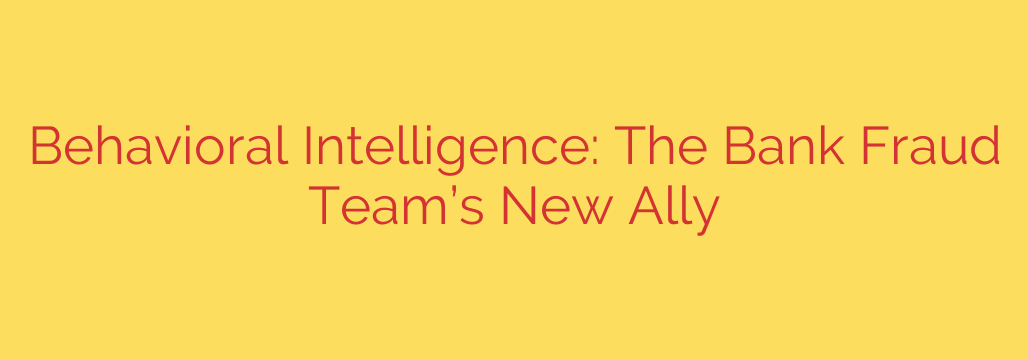
Beyond Passwords: How Behavioral Intelligence is Redefining Bank Security
In an age where data breaches are common and cybercriminals are more sophisticated than ever, the simple password is no longer enough to protect your financial accounts. We’ve all been taught to use complex, unique passwords and enable two-factor authentication, but fraudsters are finding ways to bypass even these measures. This has left banks and their customers searching for a more robust, dynamic line of defense.
Enter behavioral intelligence, a groundbreaking technology that is quietly revolutionizing the fight against financial fraud. Instead of relying solely on what you know (like a password) or what you have (like your phone), this technology focuses on who you are by analyzing how you naturally interact with your devices.
The Cracks in Traditional Security
For years, the combination of a username and password has been the gatekeeper of our digital lives. But this model has a fundamental flaw: credentials can be stolen. Through phishing scams, malware, and massive data breaches, criminals can acquire the very keys to your financial kingdom.
Even multi-factor authentication (MFA), while a critical security layer, isn’t foolproof. Sophisticated scams can trick users into approving fraudulent login attempts or intercept verification codes. This reality has forced the security industry to ask a critical question: How can we verify a user’s identity with greater certainty, even if a criminal has their login details?
What Exactly is Behavioral Intelligence?
Behavioral intelligence, also known as behavioral biometrics, is the science of identifying a person based on their unique patterns of interaction with a computer or mobile device. It operates silently in the background, building a profile of your distinct digital mannerisms.
Think of it as your digital signature. Just as your handwritten signature is unique, so is the way you navigate a website or app. This technology analyzes hundreds of micro-behaviors, including:
- Typing Cadence: The rhythm and speed at which you type your name, password, and other information.
- Mouse Movements: How you move your mouse, the speed of the cursor, and the way you click and scroll.
- Device Handling: The angle at which you typically hold your phone, the pressure of your taps, and the way you swipe.
- Navigational Habits: The common paths you take within your online banking portal.
These patterns are incredibly difficult for a fraudster to mimic, even if they have your correct username and password.
How Banks Stop Fraud in Real-Time
The power of behavioral intelligence lies in its ability to detect anomalies instantly. Here’s how it works in a typical banking scenario:
- Creating a Baseline: The first few times you log into your account after the system is implemented, it passively observes your behavior. It learns your unique typing speed, mouse patterns, and device orientation to create a baseline profile that represents you.
- Continuous Monitoring: Every time you or anyone else attempts to log in, the system compares the real-time behavior to your established profile.
- Flagging Risk: If the system detects a significant deviation, it flags the session as high-risk. For example, if your credentials are entered but the typing rhythm is frantic and unfamiliar, or the mouse movements are erratic, the system recognizes this isn’t you.
Crucially, this allows banks to stop account takeover fraud before any damage is done. Instead of cleaning up the mess after a fraudulent transaction, the system can block the login attempt or trigger an additional verification step, neutralizing the threat immediately.
The Dual Advantage: Frictionless Security and Enhanced Trust
One of the most significant benefits of behavioral intelligence is that it enhances security without sacrificing the user experience. For legitimate customers, the technology is completely invisible. You simply log in and use your account as you normally would.
This creates a “frictionless” security environment. You are less likely to be bothered with constant requests for secondary authentication when the system is already confident that it’s you. For the bank, this means they can reserve high-friction security steps for genuinely high-risk situations, reducing customer frustration and building trust.
Actionable Security Tips for Today’s World
While banks are adopting advanced technologies like behavioral intelligence, personal vigilance remains your first and best line of defense.
- Practice Good Password Hygiene: Continue to use strong, unique passwords for all your important accounts, especially financial ones. A password manager can help you generate and store them securely.
- Always Use Multi-Factor Authentication (MFA): Enable MFA on every account that offers it. While not infallible, it remains one of the most effective ways to prevent unauthorized access.
- Be Skeptical of Unsolicited Communication: Banks will never call or email you asking for your full password, PIN, or login verification codes. Treat any such request as a scam.
- Monitor Your Accounts: Regularly review your bank and credit card statements for any transactions you don’t recognize and report suspicious activity immediately.
The fight against fraud is a continuous evolution. As criminals devise new methods of attack, our defenses must become smarter and more adaptive. Behavioral intelligence represents a monumental leap forward, shifting the focus from static credentials to the dynamic, living patterns of human behavior—creating a safer and more seamless digital world for us all.
Source: https://www.helpnetsecurity.com/2025/07/29/seth-ruden-biocatch-financial-institutions-fraud-prevention/








